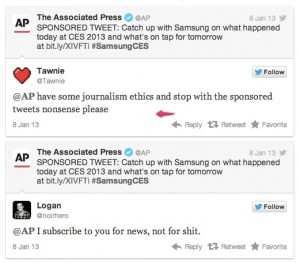
Even when you know what’s coming, you never know exactly what’s coming.
Paid, owned and earned media are converging, sure. As a result, workflow and roles are changing radically. But even when you’ve been watching this space microscopically for many months, the next manifestation to come down the pike is almost always a surprise.
The first surprise of this year is a stunning example of how quickly media convergence is moving, and how rapidly roles and workflow are changing. Last week, during CES, Samsung paid the Associated Press to run sponsored tweets in the AP’s Twitter feed.
And the “media buy” was brokered not by a media buying (advertising/paid media) agency, but by Edelman, Samsung’s PR agency (earned media – or make that paid/earned media?).
[Disclosure: Edelman is a client of my employer, Altimeter Group]
By definition, PR agencies don’t buy media, right? Just a couple of weeks ago I was talking with the New York Times about Ricochet. Many of the initial campaign results are truly impressive, but since the product involves “buying” New York Times content (not just ad units), the market is confused. Media buyers are calling it a PR product. PR is saying if it’s a buy, then it’s a media buy.
Digital silos, a new twist on that classic waiter’s line, “Sorry, but this isn’t my table.”
Disruption Across the Board
A PR agency functioning as media buyer isn’t the only radical shift in this bold experiment. For as long as there’s been publishing, it’s been pretty much the rule that the publisher sells advertising on his own media property. Now, while Twitter can arguably be defined as owned media because AP controls what’s on their feed, with this campaign they are selling sponsorships on Twitter – and Twitter doesn’t get a cut of the revenue.
Precedent? And how. As Carree Syrek of Kinetic-Social put it to Adweek, “What if Target or Walmart want to start charging CPGs like Procter & Gamble for Foursquare ads? Will the social media platforms allow brands to leverage those properties twice without having to [pay]? Will they let them essentially double dip?”
Twitter’s letting this one go, for now, despite the fact it pulls a U-turn around Twitter’s own ad product. All parties were quick to point out the sponsored tweets weren’t automated and otherwise complied with Twitter’s sponsored tweet guidelines.
Pushback? Some, which is to be expected. Criticism came both from users (a handful) and a few media observers, who worried the move blurred the lines between breaking news and pay-to-play content.
But very much to Samsung’s credit, the sponsored tweets, limited to a very modest two per day for the five-day duration of CES (so 10 tweets in total) were very clearly marked “SPONSORED TWEET.”
Edelman’s EVP/Global Strategy and Insights Steve Rubel has blogged articulately about how his firm reached the bold decision to venture into paid media, where few, if any, PR firms have gone before. The post is worth a read.
Steve and I carried on a conversation (on Twitter, over DM of course) about the campaign. No word from him on the specific goals of the undertaking, the applied metrics or results (in his defense, it was ongoing when I asked).
Like him, I believe this type of campaign is a glimpse into the future in which brands partner with the media companies they formerly ‘just’ advertised with. There are opportunities for native advertising, curation, sponsorship, creation and more.
Is there a revenue model behind this that can sustain media companies, particularly as their traditional ad revenues continue to erode? That’s the question.
In the meantime, it’s important to note Samsung’s sponsored tweets in AP’s Twitter feed very thoroughly satisfied one campaign goal that’s very squarely in Edelman’s wheelhouse: it drove a ton of (earned) media coverage.
This post first published as a column on iMedia
